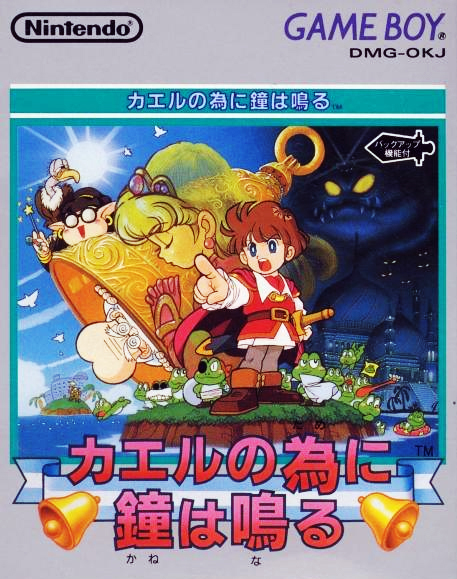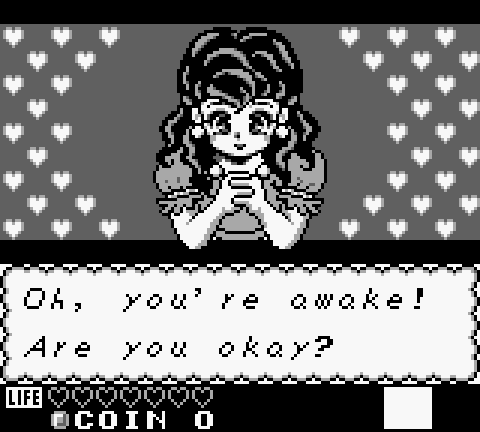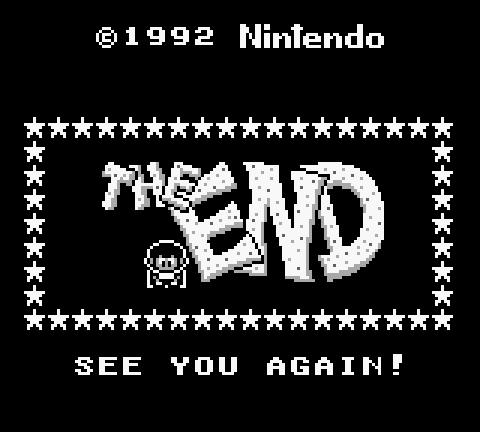Welcome to the Bucketlog! It's going to be 2019's year-long blog series, focusing on games I've been meaning to play since forever. I've put together a list derived from a mix of systems, genres, and vintages because it's starting to look like 2019 might be the first "lean" year for games in a spell (though time will tell whether that pans out to be true) and I figured this would be a fine opportunity to finally tick off a few items I've had on my various backlog lists/spreadsheets for longer than I'd care to admit.
September

- Game: Nintendo R&D1's Kaeru no tame ni Kane wa Naru ("The Frog For Whom the Bell Tolls").
- System: Game Boy.
- Original Release: 1992-09-14.
- Time from Release to Completion: Twenty-seven years, sixteen days.
Last year (and the year prior to that, though only briefly) I played a little game called Marvelous: Mouhitotsu no Takarajima for the Super Famicom. The game enjoys a sort of retrospective fame as the first project that Eiji Aonuma ever directed: the man who would eventually take stewardship of the Legend of Zelda franchise, with Marvelous itself being an action-adventure game made in the A Link to the Past engine with a stronger emphasis on narrative and puzzles and less on combat. Kaeru no tame ni Kane wa Naru - which can be translated as either "The Frog For Whom the Bell Tolls" or "For the Frog, the Bell Tolls" based on the famous John Donne "ask not, it tolls for you" bit from his Devotions upon Emergent Occasions that was later used as the title for an Ernest Hemingway novel (the game is considerably lighter than both, fortunately) - is the chronological inverse of Marvelous. That is, the Zelda game that would eventually appear on the Nintendo Game Boy, Link's Awakening, is based on the engine created for this game. I swear that the timing of the Switch version of Link's Awakening releasing this month is pure coincidence.

Despite sharing an engine and a strong visual resemblance, the two games exhibit considerable mechanical differences. In Link's Awakening, there's a side-scrolling perspective that is used sparingly in certain dungeons, recreating the effect you'd have in the original The Legend of Zelda where you'd go down a staircase into a single side-view room with a useful item or passage to another part of the dungeon. Link's Awakening had the uncommon item of a Roc's Feather that allowed Link to jump, which allowed the developers to build up these side-scrolling areas into little 2D platforming stages. In Kaeru, the side-scrolling areas make up the majority of the game's "action" sequences, while the top-down is mostly used for exploration and speaking to NPCs. It's a bit more like the SNES The Legend of Mystical Ninja, splitting its time almost equally between side-scrolling dungeon crawling and top-down overworld/town navigation. The other major difference between your typical Zelda game and Kaeru is the way combat works. Kaeru's combat is entirely automatic: upon encountering an enemy, the protagonist and his foe exchange blows until one of them falls. The way to win is to ensure your stats are as high as they can be; that might mean exploring the nearby overworld for power-up items, buying a new shield at the store, or acquiring a specific item that can be used mid-battle to turn the tide. Invariably, a tough story-critical enemy serves as a roadblock until the game is satisfied that you've made all the progress you can, at which point the hero will narrowly win this battle of attrition and be allowed to progress. Battles are also occasionally necessary for earning capital - the Prince has a nasty habit of giving all his money away, as it holds no value for a wealthy royal like himself - but are otherwise something you want to avoid for the sake of keeping your HP up for the tougher conflicts ahead.

Gameplay differences aside, Kaeru no tame ni Kane wa Naru does share Link's Awakening's silly sense of humor. While A Link to the Past had several moments of levity, Link's Awakening always felt a little more ridiculous and iconoclastic with its humor at times: a meta wink to the audience here and a "wait, you can't do that" subversion of norms there. Kaeru is frequently poking at the conventions of the RPG genre, despite barely counting as one, and painting its noble protagonist the Prince of Sable as a well-meaning but obliviously naive dolt. That he has to share the stage with his far more competent rival, Prince Richard of the Custard Kingdom, who starts the game by leaving him behind so that he can solve the game on your behalf is one of many self-deprecating gags that Link's Awakening, and later the Mario & Luigi RPGs, would have in no short supply also. The excellent fan localization from ryanbgstl and Eien Ni Hen is able to capably convey this jocular tone, even tossing in references to '70s-'80s soft rock band Air Supply by way of a group of miners who call themselves "Ore Supply" (I have no idea if this joke was in the original text) or a detour where the Prince has to briefly visit the "Nantendo FunCenter" to upgrade his strength wristband to a Power Glove in order to push aside an absurdly large boulder blocking the path to the next story objective.

Kaeru's greatest strength is also, paradoxically, one of its biggest weaknesses. At several points in dungeons, you'll need to change the Prince into one of two animals: a frog with a massive vertical leap, which he'll turn into whenever he is dunked into cold water Ranma 1/2-style, or a snake that can crawl through narrow passageways and bite weaker enemies to turn them into climbable blocks (snake venom works a little differently in this world). Switching to a frog is simple enough if there's a pool of water nearby, but becoming a snake requires eating a "hot springs egg" while turning back into a human from either form needs a "joy fruit": both of these have a finite supply in your inventory (though they're relatively cheap to restock) and so if you run out in the middle of a dungeon you'd need to bounce out via a warp device and go stock up at the nearest town's shop. Dying will also cause you to wake up in the nearest town's hospital. In both cases it resets all dungeon progress save the chests you've already opened. One way to get around this is to save the game regularly, as you can do so anywhere and the game will record your progress down to the exact spot you were standing, but that also means resuming from when you last remembered to save. Minor quality-of-life quibbles, and perfectly common ones for a game made in the early '90s, but they served to make one dungeon in particular stretch on longer than I was happy with.

On the whole, though, the game has held up remarkably well for a twenty-seven-year old Game Boy game, arguably as well as Link's Awakening itself in some respects, and that's in part due to its innovations, its irreverence, and its slight and easygoing nature. It doesn't demand RPG tactical superiority or overly taxing platforming skills, but instead has a more narrative-focused progression that rewards those who meticulously seek out NPC clues and thoroughly explore their surroundings for the items and power-ups they'll need to take down the foes in their path. The story progression is as linear as it gets, so no worries about getting lost at any point, and the entire overworld can be crossed in a matter of minutes. The split top-down/side-scrolling is impressive on a system with such limited specs, and the game is attractive and visually distinctive for what little screen real estate it has to work with. I would also be remiss in not mentioning the sound composer Kazumi Totaka, he of the mysterious "Totaka's Song," who lends the game a soundtrack perfectly germane to its lovably idiosyncratic personality. It doesn't surprise me at all that the ingenious level of development put into this game, which was a dual project of Nintendo's R&D1 division and their Fire Emblem/Advance Wars subsidiary Intelligent Systems, would soon be recycled for one of Nintendo's most important flagship properties. You might even call it the Doki Doki Panic of the Game Boy platform.

If you've played Link's Awakening for Switch or will in the near future and ever wondered what the deal is with that Prince Richard guy surrounded by frogs, consider hunting down the means to play Kaeru no tame ni Kane wa Naru with the localization patch. It's another important chapter of Nintendo history that we in the west originally missed out on that I hope is introduced to more people someday via a lavish remake. It seems only fair, given what happened to its Zelda protégé.

Log in to comment